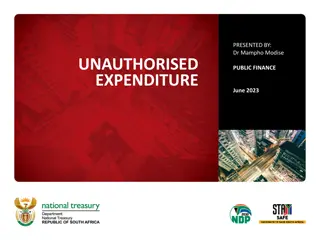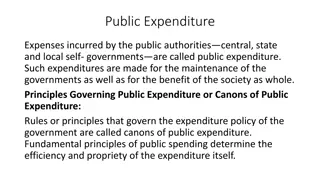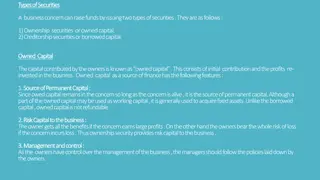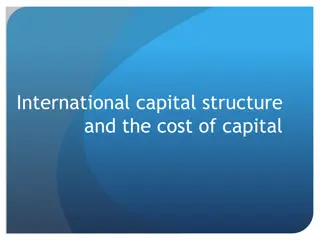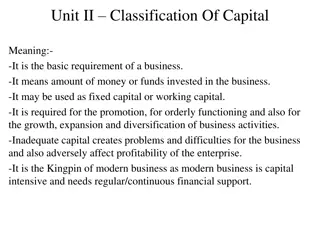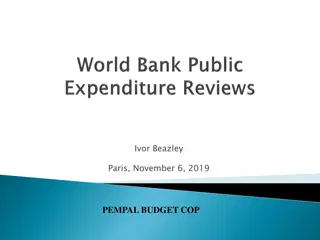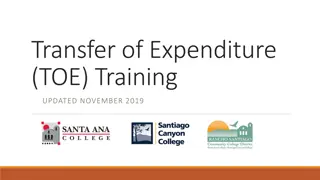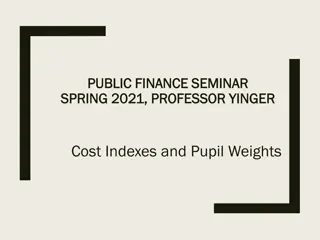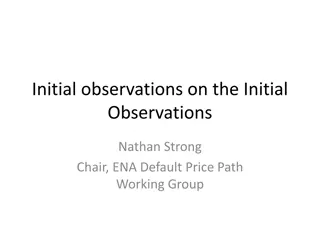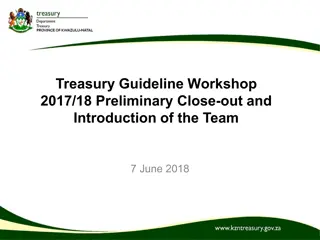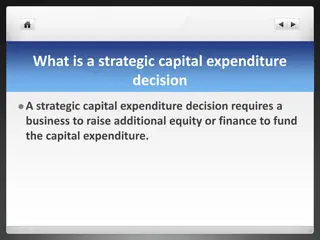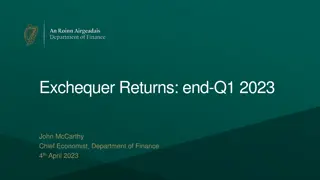Insights on Election Expenditure Monitoring in Indian State Assemblies
This presentation by Ajay Bhadoo, Deputy Election Commissioner, delves into the significance and regulations surrounding election expenditure monitoring in states like Mizoram, Telangana, Chhattisgarh, Rajasthan, and Madhya Pradesh. It covers the impact of money power, legal provisions, types of ele
0 views • 56 slides
Election Expenditure Monitoring in Karnataka State Legislative Assembly Elections
Presentation on the impact of money power in elections, the objective of election expenditure monitoring, legal provisions, machinery involved, role of expenditure observers, and focus areas for monitoring. Details on cases of rescinding elections due to detected money use, types of election expendi
0 views • 59 slides
Briefing to the Standing Committee on Appropriations on Adjustments Appropriation Bill
The presentation by Ms. Funani Matlatsi, DDG: CFO District Development Model, covers the adjustments in the national expenditure outcome, rationale for unallocated funds, impact on LGES, financial performance of the Municipal Infrastructure Grant, measures to mitigate fund stopping, steps to settle
3 views • 37 slides
Contrasting Public Finance and Private Finance
Public finance involves the income and expenditure of governmental bodies, focusing on societal welfare, compulsory nature, coercive revenue collection, and long-term welfare objectives. In contrast, private finance pertains to individual financial operations, voluntary nature, income adjustments to
9 views • 42 slides
CAPITAL STRUCTURE
Capital structure refers to the mix of a firm's capitalization, including debt, preference share capital, equity share capital, and retained earnings. Choosing the right components of capital is crucial based on the organization's function and risk level. Different patterns/forms of capital structur
1 views • 6 slides
Types of Business Expenditure and Capital Expenditure Explained
Learn about the different types of expenditure in business, including capital expenditure on non-current assets like tangible and intangible items, and revenue expenditure for day-to-day trading activities. Explore examples such as machinery, goodwill, patents, trademarks, and more. Understand the d
3 views • 11 slides
Understanding Income and Expenditure Account in Accounting
Income and Expenditure Account, similar to the Profit and Loss Account, records revenue items on the credit side and expenses on the debit side. It follows the accrual concept and reflects only the current period's incomes and expenses. Surplus or deficit is shown based on the excess of income over
0 views • 4 slides
Theories of Capital Structure and their Applications
The theories of capital structure explore the relationship between debt and equity in a firm's financing decisions. By optimizing the mix of debt and equity, a company can minimize its cost of capital and maximize its value. The Net Income Approach highlights the benefits of using debt to lower the
1 views • 7 slides
Factors Influencing Economic Growth: Human Capital and Capital Goods
Factors such as investment in human capital, capital goods, natural resources, and entrepreneurship play a crucial role in determining a country's economic growth. Human capital encompasses the skills and abilities of workers, while capital goods are the tools and equipment used to produce goods and
2 views • 28 slides
Aditya Birla Capital Scholarship for Classes 1 to 8.
The Aditya Birla Capital Scholarship is run by the Aditya Birla Capital Foundation and is designed to help students in Classes 1 to 12 and undergraduates with financial aid for their education. The program provides a one-time scholarship of up to INR 60,000 to cover academic expenses. \nTo Know More
0 views • 5 slides
Aditya Birla Capital Scholarship for Classes 9 to 12.
The Aditya Birla Capital Scholarship:\nThe Aditya Birla Capital Scholarship, run by the Aditya Birla Capital Foundation, aims to help students in school and college by offering financial aid and educational support. The scholarship provides up to INR 60,000 (one-time) for academic expenses, and st
1 views • 5 slides
Understanding Unauthorised Expenditure in Public Finance Management
The presentation by Dr. Mampho Modise delves into the concept of unauthorised expenditure in public finance management as defined by the Public Finance Management Act of 1999. It explains the implications of overspending on votes or main divisions and provides insights into how unauthorised expendit
1 views • 24 slides
Principles Governing Public Expenditure: Canons of Public Spending
Public expenditure refers to expenses incurred by government authorities for maintaining governance and societal well-being. The canons of public expenditure guide governmental spending by emphasizing social benefits, efficiency, proper sanctioning, and fiscal prudence to avoid deficits.
3 views • 26 slides
Mutual Capital Investment Fund: Addressing Capital Needs in the Insurance Community
Mutual Capital Investment Fund, LLC, aims to provide capital to mutual insurance companies facing capital needs without converting to stock form or selling minority interests. Led by Mutual Capital Group, the Fund seeks commitments up to $100 million and offers a unique investment opportunity for mu
0 views • 8 slides
Types of Securities: Owned Capital vs Borrowed Capital in Business Financing
Owned capital, contributed by owners, provides permanent risk capital to a business with high returns but lacks withdrawal flexibility. Borrowed capital, obtained through loans, offers fixed-period finance with tax advantages and flexible repayment options, but involves fixed interest payments and i
1 views • 9 slides
Irish Government Children Expenditure Study 2019
The Irish Government's Department of Children and Youth Affairs conducted a pilot study in 2019 to analyze the expenditure on children. The report aims to develop a methodology for transparent assessment of spending on children to ensure it meets their current and future needs. Key findings indicate
4 views • 4 slides
Understanding International Capital Structure and Cost of Capital
Explore the concept of international capital structure and its impact on the cost of capital, including discussions on cost of equity, investment decisions, market segmentation, and cross-border financing. Learn how firms can lower their cost of capital through internationalization strategies, such
0 views • 19 slides
Features of an Appropriate Capital Structure and Optimum Capital Structure
While developing a suitable capital structure, the financial manager aims to maximize the long-term market price of equity shares. An appropriate capital structure should focus on maximizing returns to shareholders, minimizing financial insolvency risk, maintaining flexibility, ensuring the company
3 views • 5 slides
Understanding Risk, Cost of Capital, and Capital Budgeting in Corporate Finance
Explore the concepts of risk, cost of capital, and capital budgeting in corporate finance, including the Capital Asset Pricing Model (CAPM), cost of equity, beta estimation, and cost of capital. Learn how to reduce the cost of capital and understand the impact of reducing the Weighted Average Cost o
0 views • 20 slides
Understanding Capital Expenditure Decisions in Financial Management
Capital expenditure decisions involve evaluating long-term investment projects in assets like buildings and machinery to maximize shareholder wealth. This process is crucial for businesses as it helps in increasing output, reducing costs, and providing contemporary goods to meet customer demands, ul
0 views • 16 slides
Understanding the Classification and Importance of Capital in Business
Capital is crucial for businesses, whether for promotion, functioning, growth, or expansion. It can be classified as promotional, long-term, short-term, or development capital. Factors influencing capital requirements include business activity, size, product nature, technology, business cycle, and l
2 views • 13 slides
Capital Gains and Assets Overview in Income Tax Law and Accounts
This content provides an overview of capital gains and assets in income tax law and accounts, covering topics such as types of capital assets, assets not considered capital assets, kinds of capital assets (short-term and long-term), transfer year of chargeability, computation of capital gains, and c
0 views • 15 slides
Public Expenditure Management and Performance Evaluation
This content discusses the importance of Public Expenditure Review (PER) as a core diagnostic tool in evaluating government finances and guiding spending decisions. It emphasizes the analysis of public expenditures over time to align with policy priorities and achieve desired outcomes, highlighting
0 views • 33 slides
Fiscal Year 2022 Capital Budget Presentation Overview
In the presentation to the Board of Finance, the Capital Committee outlines the Fiscal Year 2022 draft capital budget, emphasizing the importance of the Capital Improvement Program and the history of the capital program investments. The proposed budget addresses the critical need for reinvestment in
0 views • 11 slides
Development of Methodologically Robust Agricultural Capital Stock Statistics by FAO
In November 2015, the Food and Agriculture Organization of the United Nations (FAO) initiated a project to enhance Agricultural Capital Stock statistics, focusing on inclusive and efficient agricultural and food systems. The project involves developing methodologies for measuring capital stock and m
0 views • 38 slides
Estimating the Cost of Capital in Corporate Finance
Explore the process of estimating the cost of capital essential for discounted cash flows models in corporate finance. Learn how to determine the cost of debt, equity capital, and the Weighted Average Cost of Capital (WACC) by combining different sources of financing. Gain insights into capital stru
0 views • 59 slides
Understanding Forward Looking Cost Base in Infrastructure Projects
Forward Looking Cost Base (FLCB) is a financial tool that helps in spreading lumpy capital expenditure over time to ensure revenue stability. It consists of key components like return of assets, return on assets, and operating expenditure. The model relies on actual expenditure, forecasts, and asset
0 views • 12 slides
City of Johannesburg SMME Expenditure Analysis: Supporting Small Businesses in 2021/2022
The City of Johannesburg's expenditure report for the 2021/2022 financial year reveals detailed spending on goods and services, with a focus on supporting Small, Medium, and Micro Enterprises (SMMEs). The report showcases expenditure breakdown by enterprise size, highlighting the substantial investm
0 views • 10 slides
Transfer of Expenditure (TOE) Training Overview
Learn about Transfer of Expenditure (TOE), including its purpose, cost principles for federal programs, accessing the TOE form, preparing a TOE, and the approval process. Understand common reasons for TOEs and the necessary steps for accurate expenditure transfers.
0 views • 14 slides
Cost Indexes and Pupil Weights in Public Finance Seminar
Explore the importance of cost indexes and pupil weights in public finance, focusing on expenditure needs, cost disparaties, and aid programs. Key concepts like expenditure need, cost index, and pupil weight are discussed along with the cost function and expenditure requirements to meet performance
0 views • 32 slides
Understanding Net Investment in Capital Assets and Its Importance
Net Investment in Capital Assets is a critical component of an entity's financial position, reflecting the value of capital assets owned. It represents the portion of the net position that is not spendable as it is invested in assets. Calculating Net Investment in Capital Assets involves subtracting
1 views • 17 slides
Assessment of Energy Expenditure in Automotive Workers: A Study at an International Occupational Health Conference
This study presented at an international occupational health conference in Valencia, Spain, aimed to assess the energy expenditure of workers in the automotive industry. The research involved measuring heart rate and energy consumption using Polar RS 400 devices, comparing results with Slovak regula
0 views • 13 slides
Analysis of Expenditure Plans in DPP Reset Working Group
The ENA's working group is examining approaches for forecasting key components in the DPP reset, with short and long-term considerations. Industry feedback focuses on data variations, categorization issues, and the need for accurate models to explain expenditure plans. Significant variation and a st
0 views • 10 slides
2017/18 Preliminary Financial Close-out Analysis
Summary of the 2017/18 preliminary financial close-out and analysis presenting provincial revenue, expenditure outcomes, and under-expenditure. It includes details on revenue collected by department, expenditure analysis by vote, and the overall under-spending of R704.594m, equivalent to 0.6% of the
0 views • 19 slides
Understanding Venture Capital: Key Concepts and Regulations
Venture capital is a form of financing provided to startup companies with high growth potential. It involves high risk and requires a long-term horizon, often coming in various forms like equity, conditional loans, and participation in management. The process includes stages such as seed capital, ex
0 views • 10 slides
Understanding Capital Adequacy Ratio (CAR) in Banking
Capital Adequacy Ratio (CAR) is a crucial metric in banking that measures a bank's capital against its risk. Also known as CRAR, it enhances depositor protection and financial system stability worldwide. The CAR formula involves dividing a bank's capital by its risk-weighted assets, comprising tier
0 views • 7 slides
Theories of Growth in Public Expenditure: Adolph Wagner's Hypothesis
Adolph Wagner, a prominent German economist, put forth a hypothesis on the growth of public expenditure, linking it to economic development. Wagner's theory suggests that as per capita income rises, public expenditure increases proportionally due to expanded traditional functions, coverage of new fu
0 views • 35 slides
Financial Risk Protection and Equity in Health Systems
This content discusses measures of financial risk protection in healthcare, including catastrophic health expenditure and impoverishment due to health payments. It highlights data from countries like Laos and Mongolia on household expenditure and factors affecting catastrophic health expenditure. Th
0 views • 15 slides
Understanding Strategic Capital Expenditure Decisions
Strategic capital expenditure decisions involve acquiring additional equity or finance to fund long-term investments that have a significant impact on a business, such as purchasing new assets like fishing boats, trucks, or machinery. These decisions are distinct from routine expenses like repairs a
0 views • 4 slides
Overview of Exchequer Returns for End-Q1 2023
The Exchequer Returns for End-Q1 2023, as reported by John McCarthy, Chief Economist of the Department of Finance, indicate a year-on-year increase in total revenue, driven by growth in tax revenue. However, non-tax revenue decreased significantly. Expenditure also saw a notable rise, particularly i
0 views • 12 slides











